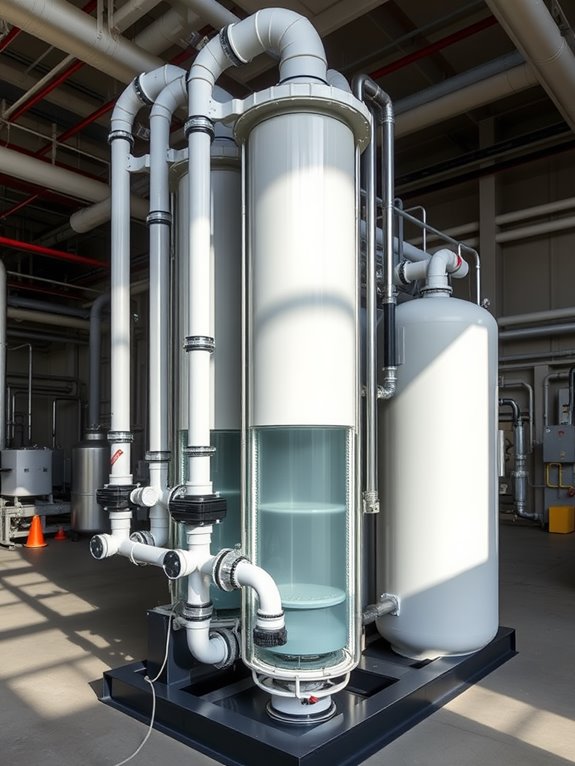A ballast water treatment system treats and purifies ballast water before it’s discharged, protecting marine ecosystems from invasive species. It reduces harmful organisms through methods like filtration, chemical disinfection, and UV light treatment. Benefits include enhanced compliance with international regulations, improved vessel efficiency, and a positive impact on sustainability efforts. As you explore further, you’ll discover different technologies and how they fit into regulatory standards and trends in ballast water management.
Understanding Ballast Water Treatment Systems

As ships navigate the world’s waters, they often take on ballast water to maintain stability, but this practice can introduce invasive species into new environments.
That’s where ballast water treatment systems come in. These systems are designed to treat and purify ballast water before it’s discharged, effectively reducing the risk of biological contamination.
By utilizing various methods, such as filtration and disinfection, these systems guarantee that harmful organisms are eliminated.
Understanding how these systems work is vital for ship operators, as adherence to regulations not only protects marine ecosystems but also helps avoid hefty fines and reputational damage.
Key Benefits of Ballast Water Treatment
Ballast water treatment systems offer several key benefits that considerably impact marine health and regulatory compliance.
By effectively reducing invasive species and pathogens, these systems help protect delicate ecosystems and native marine life.
You’ll also find that implementing these technologies can enhance your vessel’s compliance with international regulations, avoiding costly fines and potential operational delays.
Furthermore, using a ballast water treatment system can improve your ship’s overall efficiency by maintaining ideal weight distribution and stability.
Ultimately, investing in these systems not only safeguards the environment but also supports your business’s sustainability goals and enhances your reputation in the maritime industry.
Don’t miss out on related tips: Read this next: Anaerobic Water Treatment Systems: Benefits, Process, and Applications
Overview of Ballast Water Treatment Technologies

When it comes to managing ballast water, various treatment technologies have emerged to address the challenges posed by invasive species.
You’ll find three main types: mechanical, chemical, and biological systems. Mechanical systems use filtration and sedimentation to remove organisms, while chemical methods rely on agents like chlorine or ozone to disinfect the water.
Biological treatments often involve ultraviolet (UV) light to kill harmful organisms without chemicals. Each technology has its strengths and weaknesses, so choosing the right system depends on your vessel’s specific needs and operational conditions.
Understanding these options helps guarantee effective ballast water management while complying with regulations.
You might also be interested in: Are Continuous Flow Hot Water Systems Good? Benefits and Considerations
Regulatory Standards and Compliance
Understanding the regulatory standards for ballast water treatment is essential for vessel operators aiming to comply with international and local laws.
These regulations, like the International Maritime Organization’s Ballast Water Management Convention, set strict discharge limits for invasive species. You’ll need to choose an approved ballast water treatment system that meets these criteria.
Regular inspections and documentation are also required to demonstrate compliance. Failure to adhere can result in significant fines or delays.
Staying updated on changing regulations and investing in reliable technology will guarantee your operations remain compliant and environmentally responsible.
Don’t underestimate the importance of this aspect of your maritime operations.
There’s more to explore! Here’s another valuable read: Are Water Filtration Systems Necessary? Benefits and Considerations
Future Trends in Ballast Water Management

As regulations evolve and environmental concerns intensify, the future of ballast water management is poised for significant advancements.
You can expect increased adoption of innovative technologies, such as automated treatment systems and real-time monitoring solutions. These tools will enhance efficiency and compliance, making it easier for you to meet stringent regulations.
Additionally, collaboration among industry stakeholders will drive research and development, leading to more effective treatment methods.
Sustainability will also take center stage, with a focus on eco-friendly solutions.
Conclusion
In the ever-changing seas of maritime trade, ballast water treatment systems act as your ship’s shield against invasive species. By embracing these innovative technologies, you’re not just complying with regulations; you’re playing an essential role in preserving the ocean’s delicate ecosystems. As you navigate forward, think of your vessel as a guardian of the blue, steering toward a cleaner, healthier future for our waters. Together, we can guarantee the waves remain vibrant for generations to come.

I’m Allen Kim, the chief editor of plumbinginto. I am a mid level plumber and assign to an local firm over 4 years of experience. During the working period, most of my experience is related to the house plumbing. I learned about the thing, when working with most experienced people in this sector, one must be as good as the inspector or better with knowledge of the project as well as the practical aspects of plumbing industry.